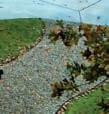TOTAL ECLIPSE OF THE STATE

FOR NEC CO-OP ENERGY MEMBERS
THE PAUL REVERE OF TEXAS
WHEN ALL IS LOST, LOVED ONES ARRIVE
MARCH 2024
Good Dog!
Trainers give canines and their owners an edge in competition









TOTAL ECLIPSE OF THE STATE

THE PAUL REVERE OF TEXAS
WHEN ALL IS LOST, LOVED ONES ARRIVE
Trainers give canines and their owners an edge in competition








From the French Quarter to the hometown of Mark Twain, experience the best of this legendary river. On an 8 to 23-day journey, explore Civil War history and travel to the epicenter of American music as you cruise in perfect comfort aboard our brand new American Riverboat™.
Small Ship Cruising Done Perfectly ®























 By Pam LeBlanc
By Pam LeBlanc
WHEN DANNY WILLIAMS, below left, started his career as a lineworker at McCulloch Electric Cooperative—which no longer exists—in 1965, color TVs were the latest technology coming into homes.
Williams and his co-workers in Brady made sure the power always stayed on for those TVs. “I loved linework,” he says. “I loved climbing.”
Williams later became an instructor, teaching work skills and safety to utility employees. And in 2007 he became manager of Texas Electric Cooperatives’ Loss Control program, where he changed (and likely saved) lives at co-ops across the state.
Williams, 80, will retire this month after more than 38 years of teaching generations of lineworkers, in a career that spanned seven decades.
“Oh, my God, how many people has he touched?” says TEC’s Curtis Whitt, a co-worker for 21 of those years. “Countless. To do it as well as he’s done it for as long as he’s done it is a pretty incredible feat.”
Visit our website to read more about Danny Williams.

Four electric school buses in South Burlington, Vermont, deliver more than students. When sitting idle during school hours, their batteries store excess renewable energy that can be pumped back onto the grid.
ENTER CONTESTS AT TEXASCOOPPOWER.COM
$500 RECIPE CONTEST
Party Drinks
FOCUS ON TEXAS PHOTOS
Shells and Scales
RECOMMENDED READING
Learn how Hoover Alexander, a fifthgeneration Texan, came to run Hoover’s Cooking, a beloved Austin diner. See A Full Plate from March 2009 on our website.

Tell us how you would finish that sentence. Email your short responses to letters@TexasCoopPower.com or comment on our Facebook post. Include your co-op and town. Here are some of the responses to our January prompt: If I could turn back the clock …
It would mean that I finally figured out how to work the buttons.
GEORGE GRAHAM
PEDERNALES EC WIMBERLEY
I would look at the clock less.
ROSIE PEÑA
NUECES EC CORPUS CHRISTI
I would talk to my mom and dad for days on end—just to hear their voices again.
LISA STANLEY
UNITED COOPERATIVE SERVICES
JOSHUA
Visit our website to see more responses.
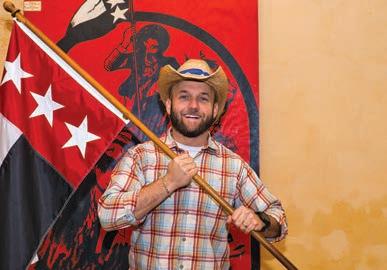
Required Reading
We love Texas Co-op Power. We homeschool and use a lot of the recipes and articles in our lessons.
Karly Woods
Via Facebook
Shamrock Memories
My wife and I stayed at the old Shamrock Hilton on the last weekend it was open [The Green Carpet, January 2024].
The place was still amazing, but it clearly had a lot of deferred maintenance, making it look a little threadbare —a remnant of a time gone by.
In the lounge, if you ordered one drink, they would keep bringing you more of the same—I guess figuring that everything they gave away was one less thing they’d have to pack up or throw away.
Mike Blanche
United Cooperative Services
Morgan

JANUARY 2024 Moment’s Notice
“There’s an expression around Laredo: ‘Six flags over Texas; seven flags over Laredo!’ ”
SHERI ULAN-SWEET
BLUEBONNET EC AND CENTRAL TEXAS EC
LEXINGTON AND FREDERICKSBURG
What Desert?
When I flew from my Southern California hometown into San Antonio in May 1968 for U.S. Army basic training at Fort Sam Houston, I was surprised by a lush, green landscape (plus millions of crickets) instead of a barren desert [How Texas Became a Desert, December 2023].
Even more shocking was finding that the Alamo had been moved to downtown from the countryside where John Wayne defended it from Santa Anna’s forces.
Steve Mallery
Heart of Texas EC Robinson
On Second Thought
I enjoyed Frederick Law Olmsted’s assessment of Austin and New Braunfels [Appraising the Texas Landscape, November 2023]. I believe he would be appalled at the destruction of the natural beauty and wildlife he witnessed in the 1850s.
Harvey H. Wetz
GVEC New BraunfelsWRITE TO US letters@TexasCoopPower.com
Editor, Texas Co-op Power 1122 Colorado St., 24th Floor Austin, TX 78701
Please include your electric co-op and town. Letters may be edited for clarity and length.
Texas Co-op Power
TEXAS ELECTRIC COOPERATIVES
BOARD OF DIRECTORS
Chair Neil Hesse, Muenster
Vice Chair Avan Irani, Robstown
Secretary-Treasurer Bryan Wood, San Augustine Board Members Dale Ancell, Lubbock
Mark McClain, Roby • Julie Parsley, Johnson
City • Brandon Young, McGregor
PRESIDENT/CEO Mike Williams, Austin
COMMUNICATIONS & MEMBER
SERVICES COMMITTEE
Mike Ables, Bellville • Matt Bentke, Bastrop
Marty Haught, Burleson • Gary Miller, Bryan Zac Perkins, Hooker, Oklahoma
John Ed Shinpaugh, Bonham
Rob Walker, Gilmer • Buff Whitten, Eldorado
MAGAZINE STAFF
Vice President, Communications & Member Services Martin Bevins
Editor Chris Burrows
Associate Editor Tom Widlowski
Production Manager Karen Nejtek
Creative Manager Andy Doughty
Advertising Manager Elaine Sproull
Communications Specialist Samantha Bryant
Digital Media Specialist Caytlyn Calhoun
Assistant Production Manager Alex Dal Santo
Print Production Specialist Grace Fultz
Food Editor Vianney Rodriguez
Senior Designer Jane Sharpe
Communications Specialist Claire Stevens
Proofreader Louie Bond
TEXAS CO-OP POWER Volume 80, Number 9 (USPS 540-560). Texas Co-op Power is published monthly by Texas Electric Cooperatives. Periodical postage paid at Austin, TX, and at additional offices. TEC is the statewide association representing 76 electric cooperatives. Texas Co-op Power’s website is TexasCoopPower.com. Call (512) 4540311 or email editor@TexasCoopPower.com.
SUBSCRIPTIONS Subscription price is $4.96 per year for individual members of subscribing cooperatives and is paid from equity accruing to the member. If you are not a member of a subscribing cooperative, you can purchase an annual subscription at the nonmember rate of $7.50. Co-op members: Please notify your co-op of address changes or other subscription requests.
POSTMASTER Send address changes to Texas Co-op Power (USPS 540-560), 1122 Colorado St., 24th Floor, Austin, TX 78701. Please enclose label from this copy of Texas Co-op Power showing old address and key numbers.
ADVERTISING Contact Elaine Sproull at (512) 486-6251 or esproull@texas-ec.org for information about purchasing display ad space in Texas Co-op Power and/or in our 26 sister publications in other states. Advertisements in Texas Co-op Power are paid solicitations. The publisher neither endorses nor

Where will you be when a once-in-a-lifetime total solar eclipse darkens Texas next month?
when the moon passed between the Earth and the sun in a celestial display known as an annular eclipse, I headed to Lost Maples State Natural Area in the Hill Country, donned a pair of goofy cardboard glasses and gazed skyward.
The field around me bristled with telescopes and tripods, all directed at the slow-moving phenomenon, which looked to my untrained eye like a frying pan slowly moving in front of a bed of glowing coals. Just as the moon lined up with the face of the sun, creating a halo of yellow, a cheer arose, and someone cranked up Johnny Cash’s Ring of Fire
As fun as that was, it was just the warmup for what’s coming April 8, when Texans will get front-row seats at an even more impressive spectacle—a total solar eclipse.
The last total solar eclipse viewable from the U.S. occurred August 21, 2017—but Texas wasn’t in the path of totality. Those who peered at it (through special safety glasses, of course) from here saw the moon’s shadow creep across the sun but never fully blot it out. Other parts of the country experienced totality.
“A really good total solar eclipse is an emotional experience,” says astronomer Phil Kelton, former assistant director and superintendent of the McDonald Observatory in Fort Davis. “They’re awe-inspiring events, like nothing else in nature. The annular eclipse was a poor second.”
In April, the eclipse’s path of totality will cross Mexico, enter Texas near Eagle Pass, and slowly crawl northeast across the state. Kerrville, Bandera and Waco are all near the centerline, so watchers there will get a good show. Much of the Metroplex will experience totality, as will parts of Austin and San Antonio.
After crossing into Oklahoma and Arkansas, the eclipse will pass through 10 more states before moving out of Maine and into Canada.
The whole event—from the time the moon first bites into the sun—will last roughly 3 hours in Texas. But the duration of totality will vary by location. In Vanderpool and Ingram,
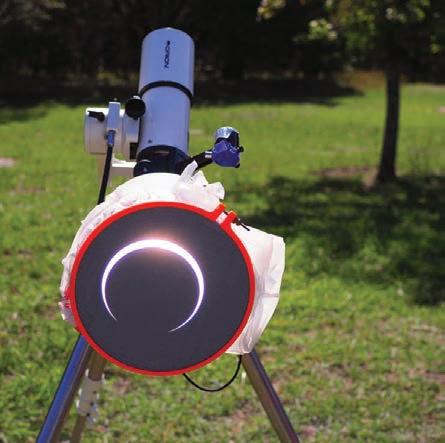
for example, it will last 4 minutes and 26 seconds; in Austin, farther from the centerline, it will last less than two minutes. The start of totality will also vary, occurring between 1:27 p.m. and 1:40 p.m. depending on where you’re viewing.
During those few minutes, skies will grow significantly darker. It’ll feel cooler, and some animals may exhibit twilight behaviors. If skies are clear—and chances of a clear sky are historically higher in Texas than they are farther north and east across the U.S. at that time of the year— bright stars will become visible.
“It’s one of the great events of nature,” Kelton says. “There’s an element of majesty and awe that occurs during a total solar eclipse. Only in the last few hundred years has man understood enough about the cosmos to appreciate what was causing it.”
Total solar eclipses occur every few years at different locations around the globe. After this year’s event, an eclipse in 2033 will impact a small part of Alaska, and one in 2044 will affect Montana and the Dakotas. The next total eclipse to carve a broad swath across the country, though, won’t take place until August 12, 2045.
Now’s the time to plan. People are traveling to Texas from all over the world for the April eclipse, and many lodges and campgrounds in the path of totality are already booked.
Don’t panic.
“The path is huge. You don’t have to be in a special place,” says Shaun Tarpley, an architect from League City who chases eclipses to photograph them. He and his wife, Ashley, an aeronautical engineer who works at NASA, traveled to Lost Maples with their son for the annular eclipse and plan to return to the Hill Country in April.

“As long as you’re in the path, you can get out on the side of a road,” he says. “If you’re in the area, you’ll be able to experience it.”
When I drove to Bandera County for the annular eclipse, I spotted fields with hand-painted “camp here” signs planted among the ash junipers and oaks.
Eclipse watchers had gathered for a celebration at Stonehenge II, a scaled-down version of the British original on the lawn outside the Hill Country Arts Foundation in Ingram. (Festivities are planned next month, too.) And at Lost Maples, campgrounds and day-use areas were packed.
Among those I met was Frederic Allegrini, an astrophysicist and amateur astrophotographer from San Antonio who drove 2,500 miles in four days to see the 2017 eclipse in Tennessee. He and his wife wanted to be in the path of totality because, as he told her, doing anything else is like being 95% in love. “It has to be 100% or nothing,” he says.
And then there was Laura Hermann of Spring, who stood
“There’s an element of majesty and awe that occurs during a total solar eclipse.”

at a table loaded with snacks and used a Moon Pie and a bag of Sun Chips to demonstrate how the eclipse would unfold.
For those with deep pockets, touring companies like Smithsonian Journeys offer luxurious guided tours through the Hill Country, with eclipse watching at Becker Vineyards near Stonewall and stops at other Central Texas sites.
For a less expensive experience, reserve a day pass at one of the Texas state parks in the path of totality. Enchanted Rock and Lost Maples will be popular destinations, but spots will fill up quickly. Reservations at Enchanted Rock open 8 a.m. March 11, and reservations for all other state parks open 8 a.m. March 8. Lower Colorado River Authority parks are another option, with special activities at some locations, including Black Rock Park on Lake Buchanan.
If your favorite park is booked, check out Campspot’s regularly updated guide of sites in the path that still have availability. At RVshare, you can book an RV directly from the owner.
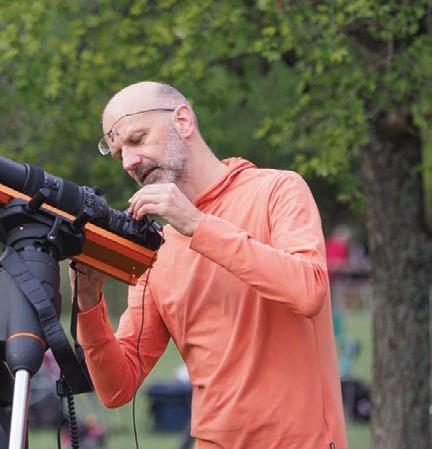
If you want a side of music with your eclipse, consider the family-friendly Eclipse Utopia at Four Sisters Ranch in Utopia. Camping is available, and the event includes workshops, disc golf, hiking, biking, yoga and two days of live music. Closer to Bandera, the Ground Zero MusicFest includes everything from live music and a classic car show to a cornhole tournament and space alien costume contest.
Wherever you go, arrive early, protect your eyes and embrace the experience.
That’s what Emma Ransome and Pavol Klacansky, both from Austin, did during the October eclipse. I found them stretched out in the grass at the campground at Lost Maples, listening to a special playlist they had compiled, grinning behind their eclipse glasses.
“We’ve been able to slowly watch it evolve,” Ransome says. “It’s very relaxing.”
And the opening act only got them more excited about the April main event. D
For more guidance about viewing safety and making your eclipse experience memorable, visit our website. And for a deeper dive into the wonders of the eclipse, check out nationaleclipse.com.

Never look directly at the sun through a camera, binoculars or a telescope without proper solar filters.
Only use glasses made specifically for eclipse viewing; they’re about 100,000 times darker than ordinary sunglasses. View the eclipse indirectly with a pinhole projector or see what it does to shadows by holding up a colander from your kitchen.
Plan ahead: Folks from all over the U.S. are already booking rooms in the Hill Country, and traffic could be tricky.

 BY MARGARET BURANEN • PHOTOS BY TOM HUSSEY
BY MARGARET BURANEN • PHOTOS BY TOM HUSSEY
Coaches help canine competitors reach new heights—and grow closer to their humans
Growing up in South Korea while her dad served in the U.S. military, Abby McMillin had two dreams. First, like Dorothy in The Wizard of Oz, she wanted to return home to Kansas.
When her family did finally move back to Kansas, McMillin started working on her other dream: becoming a veterinarian. In high school she started working at a veterinary clinic. There she met a dog that would change her life and her career path.
Taz was a large German shepherd. He was scared and aggressive. Nobody could get near the snarling animal. McMillan decided to try to reach him anyway.
She tossed kibble into his kennel, not even making eye contact with him. She also sometimes sat with her back to the outside of the kennel door. “I just wanted Taz to know that I was there,” McMillin says.
Gradually Taz calmed down and began to trust McMillin. He allowed her to pet him and put a leash on him. Later he accepted affection from other people. Eventually he was adopted by a woman who gave him the loving home he deserved.
The clinic’s veterinarians were amazed at McMillin’s success with Taz. They sent her to work with a professional trainer to learn more about dog behavior.
“He became my mentor,” McMillin says. She realized that communicating with dogs and other animals, trying to figure out what they needed and why they behaved in certain ways, interested her much more than animal health.
Today McMillin is the owner of Triple H Dog Training, where she teaches classes of humans and canines how to work together at her facility in Mineola, northwest of Tyler.
In short, she coaches dog athletes.
Every year, the American Kennel Club and other organizations host thousands of dog sporting events across the U.S. that draw more than 1 million competitors.
But 35 years ago, in 1988, when the United States Dog Agility Association organized the first major sporting competition for dogs—the Grand Prix of Dog Agility World Championships—just 79 competitors from across the U.S. came to Houston for the three-day event. Today, more than 100 events nationwide qualify dogs and their humans—representing more than 20 countries—for regional championships and, ultimately, the world finals.
The sports encompass a range of competitions for dogs, including agility and herding, racing and jumping, obedience, and tracking and hunting trials. The growth of dog sports has become big business as trainers like McMillin build careers out of teaching people how to compete alongside their pets.
McMillin, a Wood County Electric Cooperative member, lives in Mineola with her husband, Nick; their 2-year-old son, Levi; and seven dogs. One dog, a Great Pyrenees mix, prefers couch lounging to dog sports. The other six, including three golden retrievers, compete.
Border collies, Australian shepherds and Shetland sheepdogs are among the most popular breeds to produce athletes, but there’s something out there for just about every dog.
If one canine sport isn’t suitable for a dog and its owner, McMillin urges the owner to try something else. Many dogs enjoy agility training, but their owners may realize they aren’t fit enough for this fast-paced sport. Rally, which involves only walking, may be a better choice.
Besides, it’s “more about relationship building, so the dog owner and dog develop a lifetime friendship,” McMillin says. “I want people to enjoy their dogs.”
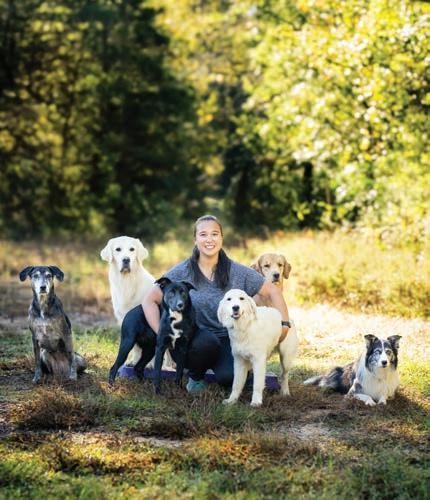

For training at home, McMillin advises dog owners to “keep it short. Keep it fun. Keep it simple. Don’t do 30 minutes once a week. Do five minutes every day. For the first week or so, the owner has to get in the habit of training, too. Remember dogs don’t work for nothing. They’re motivated by treats or toys.”
McMillin uses a hand-held clicker to reinforce behaviors. With this method, she has also trained horses and cats, even an otter. Training allows the dog and owner to become a team and have a closer relationship. “It’s not about the ribbons,” she says. “It’s about going home with the best dog ever.”
Another trainer, Debi Krakar, started the Dog Alliance in Cedar Park, outside Austin, in 2006. There she trains therapy dogs and offers classes in various dog sport disciplines.
Krakar, a member of Pedernales Electric Cooperative, says that the raft of dog sports offers an excellent outlet for pups. “When they’ve been mentally stimulated and exercised, they won’t eat your shoes,” she says. “Dog sports build a bond between human and dog. They understand each other better.”
Krakar got into dog training after taking her own dog to schools for children to read to. “ Teachers kept calling me,” she says. “The demand for these therapy dogs is constant.”
For owners who aren’t sure which dog sport might be best for them and their pups, she offers a dog sports foundation class that covers the basics. Because when it comes to man’s best friend, it’s really about building relationships.
“Have fun and be positive with your dog,” Krakar says. “In the long run you’ll have a much stronger bond with your dog.” D

AGILITY Dogs run through an obstacle course that includes tunnels, blocks to jump on and vertical poles to weave through.
BARN HUNT Popular in rural areas, dogs run into barns and signal where rats are hiding.
DISC DOG This is a variation of the basic game of fetch. The dog’s owner throws a flying disc that the dog catches (usually by jumping up in the air) and retrieves quickly.
DOCK DIVING Dogs race down a ramp and leap out into a pool of water to retrieve a toy thrown by the owner.
FAST CAT No felines are involved! Short for coursing ability test, dogs of any breed are timed as they race around a 100-yard track, chasing an artificial lure
LURE COURSING Sight hounds race around an oval or rectangular course that measures 650–800 yards, chasing an artificial lure
RALLY Dogs walk to various stations and follow various commands from their owners at each one.
SHED HUNT Pups retrieve shed deer antlers from a field within a set time period.
TRACKING Dogs follow the scent of a lure that was earlier dragged through a course.
TRICKS Beyond the basic commands of sit, stay, come and lie down, dogs learn to perform more advanced commands or follow hand signals.
It was a warm summer afternoon and my wife and I were mingling with the best of them. The occasion was a 1920s-themed party, and everyone was dressed to the nines. Parked on the manse’s circular driveway was a beautiful classic convertible. Never ones to miss an opportunity, we climbed into the car’s long front seat. Among the many opulent features on display was a series of dashboard dials that accentuated the car’s lavish aura. One of those dials inspired our 1920s Retrograde Watch. What does retrograde mean? Instead of displaying the hands rotating on an axis like most watches, the hands sweep in a semicircle, then return to their starting point and begin all over again. Retrograde watches by the big brands can set you back thousands; but because we’ve designed the 1920s Retrograde Watch in-house, we can offer it to you for just $99!


This watch is so wildly popular with our customers that we’re actually concerned about running out; we only have 937 729 left for this ad!
Watch Specifications:

• Precision movement • Stainless steel case, caseback and crown
• Retrograde hour and minute indicators • Water-resistant to 5 ATM
• Brown genuine leather band • Fits wrists up to 8”
1920s Retrograde Watch $399
*Special price










also receive a handpicked trial selection of fascinating coins from our No-Obligation Coins-on-Approval Service, from which you may purchase any or none
– return balance within 15 days – with option to cancel at any time.
year of the classic series – survived. Never to be minted again, this historic Morgan dollar can be yours for just $29.95 (regularly $87.00) –SAVE 65% off regular prices! Order today and get FREE shipping to your home!

WE USE ELECTRICITY in our homes throughout the day, but we rarely think about how it gets to the wall outlets or switches.
Distribution lines bring electricity to homes and most commonly connect to a house through a service drop. The electricity goes through the meter box to the service panel, which is typically found on an outer wall or in the garage. The service panel, often called a breaker box, is where breakers and fuses protect the wires inside your house from electrical overload.
With so much electricity funneling out of the breaker box through the rest of the home to your outlets and switches, it’s important not only to know how to use a breaker box but also how to do so safely.
Here’s what you need to know about the breaker box safety features that you’ll find in the panel:
e Main circuit breaker. This switch goes on and off to regulate the current flow. If an overload occurs because of a short circuit or because too many appliances are running at the same time, the circuit breaker will automatically trip to turn off the current flow. Breakers are subdivided into two categories.
Single-pole breakers: These single switches are typically between 15 and 20 amps, are found in most circuit breakers, and can handle up to 120 volts.
Double-pole breakers: These breakers can have various amperages and can take on 240 volts. Double-pole breakers are
made for large appliances such as air conditioners, water heaters, washing machines and stoves.
e Arc-fault circuit interrupters. These breakers are specifically geared to produce additional safety measures against electrical fires and electrocution. Arcing faults can be triggered by overloaded circuits, damaged wires, cracked wire insulation, loose or improper connections, faulty electrical equipment, or overheated electrical wires. An AFCI monitors current flow and can distinguish between normal, working arcs and unwanted, dangerous arcs. When an unwanted arcing condition is detected, it shuts down the circuit immediately.
e Subpanels. Subpanels are small breaker boxes geared to take on more circuits when you don’t have the space to contain new circuits.
e Bus bars. The two rows in the main circuit breaker panel link up with hot bus bars. This is where the current flows from the main breaker to the dividing circuits and extends to the outlet.
If an appliance is malfunctioning, there’s another electrical malfunction in your home or the circuit breaker flipped during a power outage, it may be necessary to cut off or switch on the power at the breaker box. If you must flip a switch at the breaker box, always remember these safety tips:
e Turn off or unplug connected equipment.
e Stay a safe distance away from the panel.
e Don’t look directly at it.
e Shield your body in case an arc occurs.
e Don’t touch exposed conductors.
Never attempt to turn off power at the breaker box if you must stand in water to do so. If you touch the breaker box while wet or while standing in water, it could cause electric shock or death. If you cannot reach your breaker box safely, call your electric co-op to shut off power at the meter.
Be sure to call a qualified electrician if blowing fuses or tripping circuit breakers are a recurring problem. This means there is something wrong with your electrical system, and it needs to be inspected.
Labeling breakers makes it safer and easier to go right to the breaker you need rather than testing several.
Protect your breaker box from weather no matter where the box is. Water can corrode connections and cause problems. You can use a weatherproof box or get your panel professionally enclosed. D
Stay in the Know

By ensuring we have your most accurate and complete information, we can continue to provide the high level of service you expect and deserve.



AT NEC CO-OP ENERGY, we’re constantly striving to improve our operational efficiency so we can provide the most reliable service possible for our members.
We rely on data for nearly every aspect of our operations, which is why we could use your help.
By ensuring we have your most accurate and complete contact information, we can continue to provide the high level of service that you expect and deserve. Up-todate information enables us to improve member service and enhance communications for continuous care. It also allows NEC Co-op Energy members to receive information about other important programs, events, and activities.
Having your phone number on record enables us to easily reach out to you with important updates, promotions, and any relevant information related to your account. This allows us to provide personalized and seamless account management.
Keeping us updated with your information also helps us when there’s a question about energy use or billing.
Discrepancies on your account can be taken care of promptly if NEC Co-op
Energy can easily get in touch with you.
Emails and phone calls are also used to notify registered members of any changes in our events.
Many of you have been members of NEC Co-op Energy for years, and it’s likely that your account information hasn’t been updated for some time. We recognize that many members now use a cellphone as their primary phone service, and we might not have that number in our system.
I want to emphasize that when you provide your contact information to us, we will never share this information with any third parties. It’s only used by NEC Co-op Energy to send important information to you.
Please take a moment to confirm or update your contact information by contacting us at help@neccoopenergy.com / 855-632-7348. By doing so, you’ll help us improve service and efficiency so we can better serve you and all members at NEC Co-op Energy.
 Varzavand "Avan" Irani Chief Executive Officer
Varzavand "Avan" Irani Chief Executive Officer

At NEC Co-op Energy, we prioritize community service by supporting important organizations such as The Ark, The Junior League of Corpus Christi, Big Brothers Big Sisters, Family Counseling Service, and others. Our active participation in local events hightlights our ongoing commitment to community support.

I n the world of the oil field industry, where precision and safety are crucial, ACE Recertification & Services, LLC stands out as a reliable partner in the recertification of iron valves and pipes. Founded in 2017 by President, Abraham Aguilar Jr. (AJ), ACE’s process is perfectly simple. First, they conduct visual inspections, then they check thickness assessments (UT inspections), and finally hydrostatic pressure testing, streamlining the recertification process with a focus on simplicity and rigorous safety practices.
The origin of ACE Recertification & Services, LLC was fueled by adversity when in 2017 Aguilar and his two colleagues were laid off. Determined to turn this setback into an opportunity, Aguilar founded ACE, creating a three-employee startup. “For years we were making other people millions of dollars…” Aguilar explains. Since then, the company has experienced substantial growth, evolving from a three-employee startup to a thriving business with a team of 16.
The company that laid them off eventually closed its Texas branch and let go of their shop hand, Lisa Garcia. Garcia found a new home with ACE and is now the head of the company's West Texas division. “We love and appreciate Lisa. Yep, that’s Lisa’s story,” Aguilar beamed. Her story is emblematic of ACE's commitment to its employees and the strong sense of camaraderie and inner growth within the organization.
ACE prides itself on being the inspection side of the oil field, dealing with all aspects of iron recertification. Aguilar emphasizes, "We mess with everybody's iron." The company's streamlined
process ensures that each piece of iron is certified within minutes, averaging an impressive 100 pieces per day. This efficiency sets ACE apart, as it accomplishes in a single day what other companies may take several days to complete.
To maintain high standards, ACE invests in employee development, attending the annual Shale Energy conference and staying updated on industry certifications. The company's dedication to continuous improvement is evident through annual equipment calibration and updated certificates for employees.
Beyond iron recertification, ACE is expanding into the rigging side of the business. Aguilar proudly states, "Having a rig-up crew is our thing, outside of recertifying. We're kind of the jack of all trades." This diversification showcases ACE's adaptability and a willingness to meet industry demands.
Above all, safety is the cornerstone of ACE Recertification & Services, LLC. Aguilar asserts, "Our objective is for everyone to go home. From start to finish. Safety doesn't only save time and headaches, but it saves lives." This unwavering commitment to safety shows in every aspect of ACE's operations.
In just a few short years, ACE Recertification & Services, LLC has established itself as a reliable force in the oil field industry. The company's journey from adversity to success, dedication to employee growth, and focus on safety illustrate its commitment to excellence in all aspects. As ACE continues to grow and diversify, its impact on the industry is sure to be felt for years to come.











NEC District 7 Director, Juan Alvarado, retired from the NEC Board of Directors in late 2023. “Nueces Electric Cooperative members and the electric cooperative community benefitted from his 19 years of generous, knowledgeable and dedicated service to NEC,” stated the resolution adopted in honor of Mr. Alvarado by the NEC Board of Directors.
Mr. Alvarado, a devoted NEC member, prioritized member service, supported Cooperative members and staff, and obtained certificates from the National Rural Electric Cooperative Association.

He selflessly served in roles as Chair of the Annual Meeting Committee and on committees like Director Screening and Finance. He believed in understanding and executing directorial responsibilities with common sense and good judgment. NEC will miss him, and his friends wish him health and happiness in retirement.
Following Mr. Alvarado's resignation, the NEC Board of Directors reviewed district boundaries to assess the most efficient way to best serve the members.. Following careful consideration, the Board decided to merge the previous District 7 members into the adjacent District 3.
The Director for District 3, NEC Secretary/Treasurer David Rosse, is ready to support and serve the expanded membership in the new District 3. With this change, District 8, served by Director Gladys Lippincott, will now be renumbered as District 7.

A COMMON APPLIANCE can put you in hot water: Water heaters account for about 18% of a home’s energy consumption. It doesn’t have to be that way.
Here are five energy-saving tips:
Lower the temperature of your water heater to “warm,” which is 120 degrees. This will save energy and slows mineral buildup and corrosion in the water heater. Another bonus: A lower water temperature lowers the risk of scalding, especially for older adults and children.
Upgrade your water heater to a newer, energyefficient model. If yours was made before 2004, when new federal energy efficiency regulations took effect, you’re spending more than you need to heat water. And by purchasing a new one, you can stave off problems like leaks and breakdowns before they happen.
If you’re buying a new water heater, choose one that “fits” your home. A water heater that’s too small for your family’s needs will be overworked, so its burner is constantly running. An oversized unit will waste energy by constantly heating more water than your family needs.
Take shorter showers. Doctors say a five- to 10-minute shower is just enough. Any more, and the hot water can dry out or even damage the surface of your skin. Any less might not be enough time to get clean and hydrate your skin.
Insulate the water heater and pipes. Install a water heater blanket made from insulating material to prevent heat from seeping into the air instead of the water.





Texas Independence Day
Saturday, March 2
Daylight Saving Time
Begins
Sunday, March 10
St. Patrick's Day
Sunday, March 17
Easter
César Chávez Day
Sunday, March 31
Office Closed
In observance of Easter and Good Friday
Friday, March 29

Some NEC Co-op Energy members may be contacted by an ERCOT consultant, called PlanBeyond, to participate in a survey in the month of March. ERCOT has been asked to undertake a Value of Lost Load (VOLL) study by the Public Utility Commission of Texas (Commission) to determine the estimated value of electric reliability in the ERCOT region.
The research involves surveying a large and diverse set of Texas customers to understand the value they place on reliable electricity service. The VOLL survey has been developed and is expected to be implemented in the month of March 2024.
This research is considered important to support the PUCT’s ongoing market design initiatives. This research may also help estimate value of reliable electricity service which can be used to assess the economic efficiency of investments in generation, transmission and distribution systems, to strategically target investments to customer segments that receive the most benefit from system improvements, and to numerically quantify the risk associated with different operating, planning and investment strategies. The power providers (competitive retailers) of Texas were required to provide contact information for their consumers so this study could be performed.
No personally identifying information was provided to the surveyor for this process. NEC Co-op Energy members who are contacted for the survey are encouraged to support this project and participate in the survey.



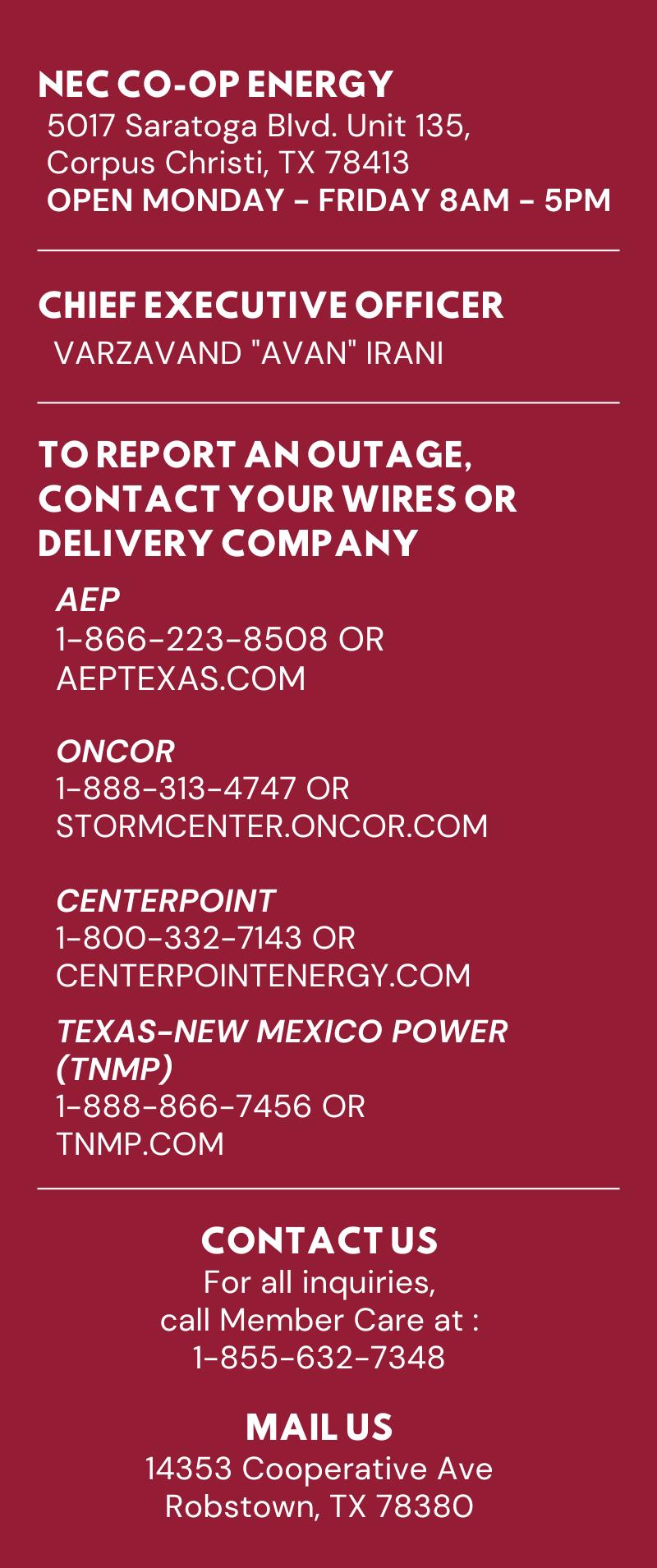







1Subject to availability, on a total purchase of 3 or more. Cannot be combined with other offers. To qualify for discount offer, initial contact for an appointment must be made and documented on or before 3/31/24 with the purchase then occurring on or before 4/10/24. Products are marketed, sold and installed (but not manufactured) by Renewal by Andersen retailers, which are independently owned and operated under Central Texas Windows & Doors LLC, d/b/a Renewal by Andersen of Austin and San Antonio. North Texas Windows & Doors LLC, d/b/a Renewal by Andersen of Dallas/Fort Worth and West Texas. See complete information and entity identification at www.rbaguidelines.com. ©2024 Andersen Corporation. ©2024 Lead Surge LLC. All rights reserved. 2Plan 4521. Subject to credit approval. Rates range from 14.26% - 21.19% APR (interest rates range from 15.99% - 24.99%). Loan amount and rate will vary based on your income and creditworthiness. 12 month promotional period (“Promo Period”) during which interest is billed but will be waived if the amount financed is paid in full before Promo Period expires. Monthly payments are not required during the Promo Period. Any unpaid balance and amounts owed after Promo Period will be paid over 84 monthly payments. For example, assuming the full credit limit is used

PAUL REVERE wasn’t the only patriot who made a courageous ride to warn of approaching danger. In 1836, Katy Jennings rode west from her home in Bastrop to the tiny town of Waterloo (known today as Austin) to alert Texians that the Mexican army was coming and they should run for their lives.
Katy was 10 years old.
Her father, Gordon C. Jennings, was a farmer who moved his family from Missouri to Bastrop in 1833. Gordon enlisted in the Texas militia, encouraged by the promise of a land grant as compensation. He served at the Alamo as a cannoneer, probably manning artillery positions on the north wall. When the
Alamo fell to Gen. Antonio López de Santa Anna’s army on March 6, 1836, Gordon, 53, was the oldest Alamo defender to die.
Author Mary Jean Kelso, a direct descendent of Katy’s brother Samuel— Kelso’s great-grandfather—wrote a book about her family, A Visual History Record of Alamo Defender Gordon Cartwright Jennings’ Family. (Kelso spells her name Katy, but a newspaper obituary called her Katie.)
When word of the Alamo reached Bastrop, most families fled east in a panicked exodus known as the Runaway Scrape. But Gordon’s wife, Catherine, and a few of her neighbors stood their ground until
a division of the Mexican army reached the Colorado River at Bastrop.
With no choice but to flee, Catherine, her three children and two stepsons threw their most valuable possessions into a wagon. Then Catherine boosted daughter Katy onto a horse bareback and sent her west to warn others that Mexican soldiers were nipping at their heels. She told Katy not to return to Bastrop because the family would be gone.
Katy was instructed to join another family when she arrived in Waterloo, and the Jennings clan would meet again in a refugee camp along the Trinity River in East Texas.
Clinging to her horse’s mane, Kelso writes, Katy rode west at “great speed” for 40 miles, warning settlers along the way. Somehow she found her way back to her family after the Battle of San Jacinto on April 21, 1836, and was with them when they returned to Bastrop.
“According to family stories,” Kelso says, “after the Texas Revolution, Katy married Casper Whistler, but the marriage was short lived. Whistler was scalped by Indians while Katy, who had gone to fetch water, hid in a creek bed.”
Katy later married a second time, to Sylvester Lockwood, a Texas pioneer. The couple lived near Manor in Travis County for 65 years. According to her 1911 obituary, Katy had eight children, 42 grandchildren, 100 great-grandchildren and 10 great-great grandchildren when she died at the age of 85.
She’s still remembered for her famous bareback ride.
“Some people may have called 10year-old Katy Jennings brave or foolhardy,” Kelso says. “Texas calls her a hero.” D
Nothing makes this gal happier than brunch. Good friends, amazing food and music in the background is my forever Sunday mood. Breakfast tostadas are so easy to prepare, and a mini version of anything is always greeted with a “wow!“

12 mini or street taco corn tortillas
3 tablespoons olive oil, divided use 6 eggs
4 teaspoons milk
2 teaspoons salt
1 teaspoon ground black pepper
2 cups refried beans, warmed Pico de gallo or salsa
1. Preheat oven to 350 degrees. Place tortillas on a baking sheet and lightly brush tortillas with 2 tablespoons olive oil. Bake until crisp, about 10 minutes.
2. In a bowl, whisk together eggs, milk, salt and pepper.
3. Add remaining 1 tablespoon oil (or you can use 1 tablespoon butter) to a skillet over medium-high heat. Pour in eggs and cook until scrambled. Remove from heat.
4. Spread beans over tostadas, spoon eggs over beans and top with pico de gallo or salsa.
Follow Vianney Rodriguez as she cooks in Cocina Gris at sweetlifebake.com, where she features a recipe for Honey Flan.

Ready in under 30 minutes, this recipe is hands-down the ultimate addition to your brunch spread, and it might be even better the next morning for a go-to breakfast.
1 package frozen puff pastry (17.3 ounces), thawed ¼ cup spicy brown, Dijon or whole grain mustard
1 pound ground breakfast sausage 1 egg, lightly beaten
1. Preheat oven to 400 degrees. Line a baking sheet with parchment paper.
2. On a cutting board, unfold the two pastry sheets. Slice pastry into thirds along the folds. Slice each third in half to make 12 rectangles. Spread a thin layer of mustard onto each pastry section.
3. Divide breakfast sausage into 12 small balls, then roll each ball into a finger-size log. Place sausage log onto end of pastry rectangle and roll it up into pastry.
4. Place sausage rolls onto parchmentlined baking sheet. Slice two small slits across the top of each roll. Brush with egg.
5. Bake 20–25 minutes or until golden brown. Allow sausage rolls to rest 7–10 minutes before serving.
MAKES 12
$500 WINNER
RUTH FILZ NUECES EC

Planning on a crowd for brunch? This heavenly French toast has you covered. No need to individually cook slice after slice—this deliciousness bakes in the oven. It can be assembled the night before and refrigerated overnight so the bread can absorb the flavorful eggy mixture. The lightly sweet, perfectly creamy goodness is worth every calorie.
SERVES 10

12 slices day-old bread
1 package cream cheese (8 ounces)
2 cups blueberries, divided use
2 eggs
2 cups milk
⅓ cup maple syrup or honey
1 cup sugar
2 tablespoons cornstarch
1 cup water
1 tablespoon (⅛ stick) butter
1. Coat a 9-by-13-inch pan with nonstick cooking spray. Cut bread into 1-inch cubes and place half of them into pan.
2. Cut cream cheese into ½-inch cubes and place on top of cubed bread. Top with 1 cup blueberries and then remaining half of bread cubes.
3. In a large bowl, beat together eggs, milk, and maple syrup or honey. Pour over bread mixture. Cover and chill in fridge 8 hours or overnight. Remove from fridge 30 minutes before baking.
4. Preheat oven to 350 degrees. Bake covered for 30 minutes, then uncover and bake an additional 30 minutes, or until center of French toast is set.
5. In a saucepan combine sugar, cornstarch and water. Bring to a boil, then stir constantly for 3 minutes. Stir in remaining 1 cup blueberries.
6. Reduce heat. Simmer 8–10 minutes, or until berries burst. Remove from heat and stir in butter. Serve warm over blueberry French toast.
MORE RECIPES >
PARTY DRINKS DUE MARCH 10
Summer soirees call for a festive frosty drink. Send us your best punch, mocktail and cocktail recipes for a shot at $500. Go online and submit your favorite by March 10.

A strata is my idea of the perfect brunch. This is prepped the night before so it’s ready for the oven the next day.
1 pound spicy breakfast sausage ½ pound diced bacon
4 eggs
½ teaspoon salt
⅛ teaspoon ground black pepper
½ teaspoon dry mustard
½ teaspoon Worcestershire sauce 2 cups milk
6 slices wheat or white bread, cubed 8 ounces grated cheddar cheese
1. Coat a 9-by-13-inch pan with nonstick cooking spray.
2. In a skillet over medium-high heat, cook sausage, breaking it up with a spoon until fully done. Remove sausage from skillet, add diced bacon and cook until crispy. Remove from skillet.
3. In a bowl, whisk together eggs, salt, pepper, mustard, Worcestershire sauce and milk.
4. Layer bread, sausage, bacon and cheese in the pan. Pour the egg mixture over the entire casserole. Using a spoon, press down to ensure that all ingredients are submerged. Cover and place in fridge overnight.
5. Remove dish from fridge. Preheat oven to 350 degrees. Bake, covered, 1 hour or until firm in center. Allow to cool for 10 minutes before serving.
SERVES 8


A small, intimate group is the way to go. Plan accordingly for your space. Make the morning about mingling. Assemble dishes the night before. Casseroles, quiches, stratas and fruit salads are perfect for this. While you’re at it, set the table, arrange glasses, and lay out serving platters and utensils.
Pick up pastries: less fuss while supporting local bakeries.
Offer a DIY bar with self-serve drinks—coffee, mimosas, mocktails. While guests help themselves, you can finish up preparations or greet guests.




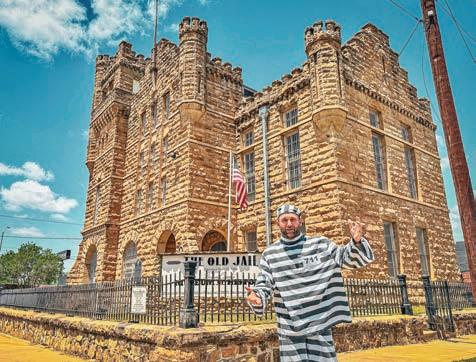
Brown County’s history museum lets visitors lock into law and order
BY CHET GARNERI ONCE WAS in Europe and wondered, “Why don’t we build more castles in Texas?”
But I was oblivious to the fact that there are already castles all around us in the form of historic courthouses and jails. That’s especially true in Brown County, where the old jail looks more like a medieval fortress than a place to dive into history.
I started my time-traveling adventure across the street from the jail at the Brown County Museum of History. From woolly mammoth bones to frontier homes, this collection covers every era of this corner of Texas between Abilene and Austin. I sat around the (fake) campfire inside a fullsized Comanche dwelling. I learned that Gilligan (aka Bob Denver) was raised in Brownwood. I also got hands-on lessons because this museum actually encourages visitors to touch the artifacts.
Most amazing was the story of Camp Bowie, which was one of the largest army training camps in the U.S. during World War II, bringing more than a quarter-million troops to Brownwood.
Things got especially interesting, and spooky, when I crossed the street and stepped inside the old jail. This lockup opened in 1903 and served Brown County until the 1980s. The smell of stone and rusted metal permeates every room. The ground floor, which was once the sheriff’s private residence, is now an incredible museum about Texas rule of law and includes stories of famous outlaws and jailbreaks.
Upstairs is where things got even creepier as I explored three floors of metal cells with heavy iron doors. I unknowingly stepped across the drop floor for the old gallows, which luckily didn’t spring open. If I was plotting a crime 100 years ago in Brown County, this simple tour would have quickly cured me of any ill intent. D
ABOVE The old county jail in Brownwood doesn’t escape Chet’s attention.
Join Chet’s captivating visit to Brownwood in the video on our website. And see all his Texplorations on The Daytripper on PBS.
Call ahead or check an event’s website for scheduling details, and check our website for many more upcoming events.
07
08
09
Austin Lakeway Garden Club Spring Mixer, (512) 263-2885, lakewaygardenclub.com
Denton [7–10] Texas Storytelling Festival, (940) 380-9320, tejasstorytelling.com
Irving [7–10] Texas Steel Guitar Jamboree, (817) 558-3481, texassteelguitar.org
Corsicana An Evening with Amy Grant, (903) 874-7792, corsicanapalace.com
Luling Rajun’ Cajun Throwdown and Gumbo Cookoff, (830) 875-3214, lulingmainstreet.com
McKinney [9–10] Heard Museum Family Campout, (972) 562-5566, heardmuseum.org
14
15
22
Dublin [14–16] St. Patrick’s Day, (254) 300-6263, dublintxchamber.com
Round Top [15–16] Pioneer Unit of Herb Society of America Plant and Gift Sale, (713) 503-9981, herbsocietypioneer.org
Tolar [15–16] Ceramic Expo and Handcrafted Items, (254) 716-5227, westceramicshow.com
Georgetown [22–23] Star Struck: Georgetown Quilt Show, (512) 869-1812, handcraftsunlimited.com
Burton [22–30] La Bahia Antique Show, (979) 289-2684, labahiaantiques.com
Brenham Mark Lowry with the Sound and Endless Highway, (979) 337-7240, thebarnhillcenter.com
Huntsville Herb Festival at the Wynne Home, (936) 891-5024, texasthymeunit.org
Johnson City [25–April 19]
and Wildflower Journey, (872) 216-9463, texashillcountrywineries.org
Burnet
, (512) 756-3059,
Sabinal [30–31] Wild Hog
and Craft Fair, (830) 486-8549, sabinalwildhogfestival.com

Corsicana [2–4]
, (903) 872-5411, navarrocouncilofthearts.com
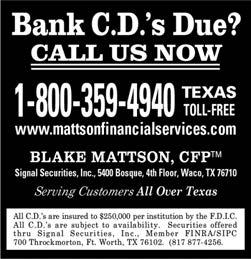













When all seems lost, loved ones rebuild a life
BY DALE ROBERSONSOMETIMES IT TAKES a tragedy to bring a family and friends together. I know. It happened to me.
My children were scattered to the four winds. Kathy in New Braunfels, Pat and Vicki in Denton; Shannon had settled in Richmond, Virginia. Kalli and Tony were in Little Elm. We weren’t estranged, just widely spread.
Since retirement, I hadn’t kept up with several friends.
The tragedy occurred in the middle of the night November 18, 2018, when my house outside Driftwood caught fire. I escaped with one night in the hospital. My wife, Joyce, died in the blaze.
Not only did I lose my wife of 41 years, I was left with only the pajamas I had on. I didn’t even have shoes.
That was when family and friends re-
grouped to help put my life back together.
Kathy took me to her house to stay until I devised a plan.
Tim McKenzie, whose late father had been a friend, called to offer an unoccupied apartment he owned.
Everyone came together to solve my problems.
As a newspaper editor, I had written about businessman Tracey Dean, then president of the Wimberley school board. When Tracey heard about my misfortune, he appeared with a sizeable check from members of his church. Then he arranged a line of credit for building materials at McCoy’s and hired a carpenter to help me rebuild.
My granddaughter, Bethany Kraft, set up a GoFundMe to raise money. Friends I hadn’t seen in some time mailed personal checks with condolences.
Granddaughters Melissa Niland and Rachel Nielsen helped set up the apartment as friends contributed furniture and clothing. Tim and grandson-in-law Brian Nielsen cleared cedar and built a pad for a foundation.
We purchased an unfinished 16-by40-foot building as my future home. With much help and my building skills, we finished the inside to my design. Grandchildren as young as 5-year-old McKinley, 12-year-old Ned and teen Chase contributed. Grandson Cliff Roberson, a professional electrician, provided lights and power. Pat hung a storm door and installed cabinet shelves while Vicki, my daughter-in-law, joined the girls.
My former wife Vicki and her friend Joe nailed down the oak flooring furnished by Tracey from a remodeling job he’d done.
Now—thanks to all their love and efforts—I’m settled and happy in my new home. It’s been said that it takes a village. A tragedy can prove what it really takes is family and friends. D










It is easy to move around with a portable oxygen concentrator.2
The Inogen® Rove 6™ weighs under 5 pounds!3


or visit Inogen.com









Inogen® Rove 6™

Coming Soon
Inogen® Rove 4™

use of a machine. The conserving, or pulse dose, oxygen delivery technique used by this device is contraindicated in persons whose breathing during normal resting would be unable to trigger the device. Proper device triggering, setup and operation must be confirmed by an experienced clinician or other respiratory professional. Not for pediatric use. Not for use by tracheotomized patients. WARNINGS: The device produces enriched oxygen gas, which accelerates combustion. Do not allow smoking or open flames within 2m (6.56ft) of this device while in use. If you feel ill or uncomfortable, or if the concentrator does not signal an oxygen pulse and you are unable to hear and/or feel the oxygen pulse, consult your equipment provider and/or your physician immediately. If you are unable to communicate discomfort, you may require additional monitoring and or a distributed alarm system to convey the information about the discomfort and or the medical urgency to your responsible caregiver to avoid harm. Use only spare parts recommended by the manufacturer to ensure proper function and to avoid the risk of fire and burns. To avoid danger of choking or strangulation hazard, keep cords away from children and pets. TALK TO YOUR HEALTH CARE PROVIDER: The oxygen flow setting must be determined and recorded for each patient individually by the prescriber, including the configuration of the device, its parts, and the accessories. It is the responsibility of the patient to periodically reassess the setting(s) of the therapy for effectiveness. The proper placement and positioning of the prongs of the nasal cannula in the nose is critical for oxygen to be delivered.

















